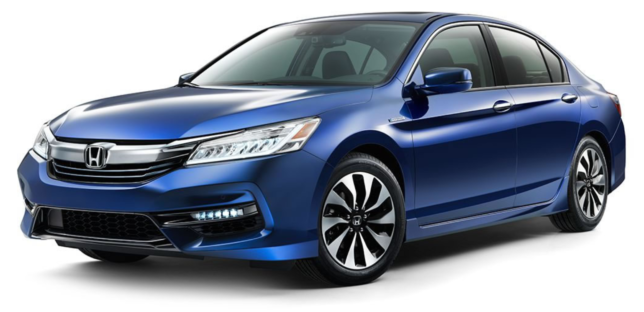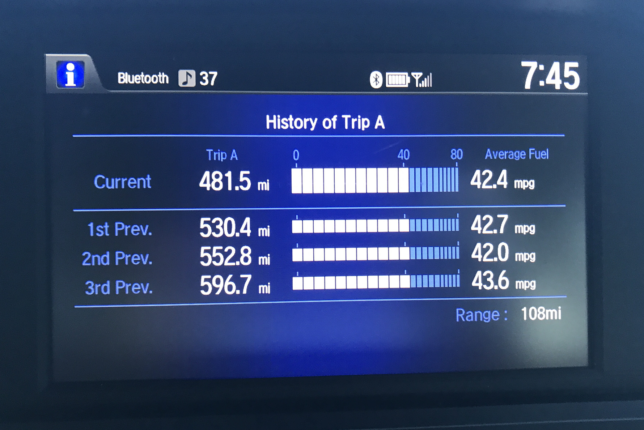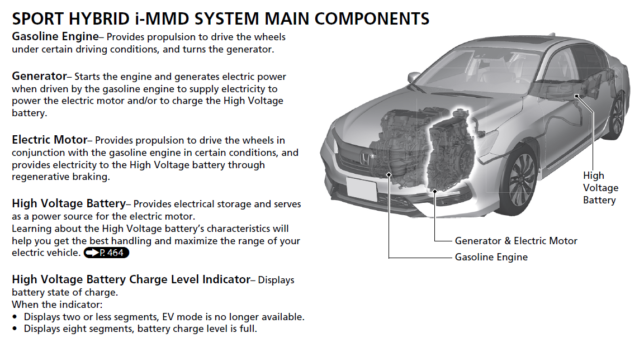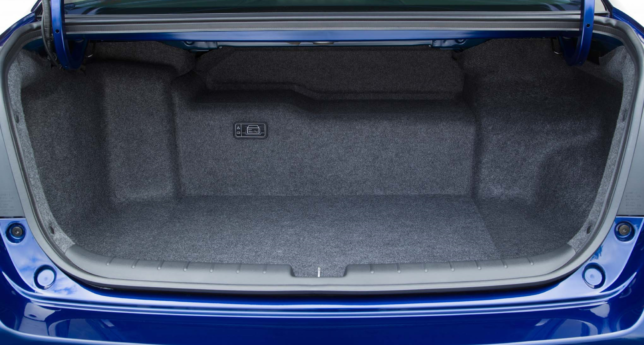 A seismic shift has occurred within my household: I finally bought a grown-up car. This has been gradually coming for a while; my previous vehicle was a 2015 Hyundai Sonata Sport 2.0T. Almost an adult car, but still a fun little Turbo. After a few months with my new Accord Hybrid, I figured it’s time to jot down some ideas that I haven’t seen reflected elsewhere.
A seismic shift has occurred within my household: I finally bought a grown-up car. This has been gradually coming for a while; my previous vehicle was a 2015 Hyundai Sonata Sport 2.0T. Almost an adult car, but still a fun little Turbo. After a few months with my new Accord Hybrid, I figured it’s time to jot down some ideas that I haven’t seen reflected elsewhere.
Mileage
First and foremost, this is a Hybrid. Hybrids should get good gas mileage; that’s the whole point. The Accord Hybrid sort-of does this. The EPA says the car should get 49 in the city, 47 on the highway, and a combined rating of 48 miles per gallon. I’m tempted to believe that if you baby the car in town, the city rating is reasonably accurate. The highway rating however is far from it. Over 3,500 miles, I’m averaging 42.37 MPG (hand calculated, not the car’s estimate). My mileage consists of approximately 80% highway and 20% city driving, and is consistent from week to week. The only real variable in my drives is how windy it might be out in the desert. Also, I stay at 75 MPH or below. I’ve noticed that going even 80 MPH causes a dramatic drop-off in economy.
 42.37 MPG is quite a ways from the combined 48. If you use my percentages and the EPA estimates above, you’d expect me to get about 47.4 MPG, so my realized mileage is about 10.6% off from the EPA estimate. Honestly, from the articles I’ve read online, I’m surprised it isn’t further off. It seems that the highway cycle that the EPA uses for testing is universally accepted as terrible for accurately gauging a typical Hybrid’s mileage.
42.37 MPG is quite a ways from the combined 48. If you use my percentages and the EPA estimates above, you’d expect me to get about 47.4 MPG, so my realized mileage is about 10.6% off from the EPA estimate. Honestly, from the articles I’ve read online, I’m surprised it isn’t further off. It seems that the highway cycle that the EPA uses for testing is universally accepted as terrible for accurately gauging a typical Hybrid’s mileage.
One major thing I’ve learned with this car is that you have to drive it correctly to maximize fuel economy. Never before have I put so much effort into learning a car that is used solely for commuting. Being a bit more easy on acceleration, maximizing braking, and utilizing the “B” mode on the CVT all combine to make a rather dramatic difference in mileage.
“Sport Hybrid”
If you look at the manual and marketing material from Honda, they advertise the 2017 as a “Sport Hybrid”. After driving the car for 3,500 miles, I truly agree. This thing has the potential to be fun! Well, at least in reasonable bursts.

The Sport mode button, located conveniently below the CVT shifter, changes the personality of the car immediately. The engine is forced on to charge the battery as fast as possible, and there are numerous changes within the ECU. The result, at least when the battery is sufficiently charged, is a lot closer to a Tesla than to a Prius. Torque off the line comes on instantaneously, thanks to the nature of having a DC motor attached to your drivetrain. I haven’t officially timed this thing, but the butt dyno tells me it is quicker to 60 than my old Sonata Turbo. Car and Driver, as well as Motor Trend, put the 0-60 time at 6.9 seconds. Not too shabby for a Hybrid. The only caveat is that you need a charge on the battery to have fun; the power from the electric motor is what makes this thing fun. No charge, no vroom. Thankfully, the car, especially in sport mode, maximizes every opportunity to keep it topped off.
Also, the tires on this car actually don’t suck! They are definitely low-rolling-resistance tires, but compared to my previous Sonata, I can go around interstate on-and-off ramps dramatically quicker. Overall handling is also improved, but for steering feedback, which I will address later. I’m not sure what the comparison between the suspensions would look like, but I know on the Sonata, tires were a weak spot. I understand that a Sonata Sport 2.0T is not the pillar by which all sport sedans are measured, but I sure thought it should be better at accelerating and cornering than my generic family-car Accord Hybrid.
Self Driving Features
First and foremost, I understand this is not a self driving vehicle. Honda doesn’t imply that it is, and nor do I. However, there are a few features that should make repetitive highway drives easier. In practice however, they may or may not help you, or aggravate you instead.
Lane Keeping Assist System (LKAS)
The LKAS is intended to keep you driving down the center of the road at speeds greater than 45 MPH. I’d like to compare the system to a cross between a puppy and a child. Some of the time, it does what it should. However, when a puppy sees a squirrel, or a child gets bored, things happen. The first is when the line on the right-hand side of the road begins to expand, such as in this photo:
 The resulting action is what I call the “Squirrel Effect”. The car notices the right line moving, completely ignores the center dashed line, and rather sharply takes off to the right. If left uncorrected, it also doesn’t follow the lane towards the exit like it seems it wants to do; it will take you directly down the middle to where you’d be driving between the main roadway and the exit itself, in what would usually be a grassy area.
The resulting action is what I call the “Squirrel Effect”. The car notices the right line moving, completely ignores the center dashed line, and rather sharply takes off to the right. If left uncorrected, it also doesn’t follow the lane towards the exit like it seems it wants to do; it will take you directly down the middle to where you’d be driving between the main roadway and the exit itself, in what would usually be a grassy area.
The second artifact stems from the car needing to know you’re still in control. After a certain period of time (which varies widely), the car will flash on the screen “Steering Required”, and discontinue the LKAS system until you place your hands back on the wheel. The problem with this is that it happens a lot even when you are holding the wheel. It seems that the system is designed to look for resistance to the adjustments it makes in steering as a sign that you’re still there. However, when traveling down a straight road, there are not many adjustments to be made by the system or the driver. This can lead to constant warnings even when firmly holding the wheel, sometimes coming as quickly as every 5-10 seconds, making the LKAS system more of a chore than an aid.
Adaptive Cruise Control (ACC)
The ACC system is a great idea in theory, especially for longer drives. By and large, the system works exactly as described in the Accord Hybrid. However, be prepared for a lower return on mileage when using the system. This stems from the fact that the car will brake, thereby losing momentum, frequently. Any time you come upon a car in your lane, even with the shortest interval selected, you will likely find the car braking for you before you’d make a normal lane change to go around it. I truly feel that the shortest distance allowed for following is still way too far. I’m sure that this is a result of the CMBS system, in that the ACC system is leaving a gap that it assumes the CMBS system can brake within should the vehicle in front stop abruptly. In practice though, it can get annoying. The same thing can happen if someone gets in front of you too closely after passing you. In addition to the gap distance between cars, the system will also brake all the way down a hill to maintain the exact cruise speed you set. This isn’t just a lack of application of power; it is literal braking, with brake lights on and all. While this slightly recharges the battery, it also kills momentum if you have another hill ahead. Most cars I have driven give you a 5-10 MPH buffer that it will allow the vehicle to exceed the speed set through the cruise control. This car seems to be the honest kid in class, sticking exactly to what you set.
Steering Feedback
The steering feedback on the Accord Hybrid has been noted in almost every review, but it is so numb, that I figured I’d reiterate it here. There is zero feedback. None. At all. You could be piloting a boat just as easily as a car. This isn’t to say that the steering doesn’t do what you’d expect it to, even through curves. It just doesn’t communicate much back to the driver.
Trunk Space
Trunk space in the Accord Hybrid is severely limited by the battery pack. I have read that it is better on the 2017’s than it was on the 2014-2015’s, but I haven’t seen an older one to compare.
 I will give props to Honda for including the shelf above the battery pack. They could have easily just ignored this area and made the wall flush with the battery all the way to the ceiling. It is a nice bonus area, if not constrained by maximum weight you can put on it. There could be a small pass-through where the center armrest comes down inside the car to allow things such as a long piece of wood to fit, Honda didn’t feel the need to include this. Also, there is no spare tire, and Honda strongly recommends against putting one in the hole, as they are concerned that upon a rear impact, it would be forced into the battery, potentially causing a leak.
I will give props to Honda for including the shelf above the battery pack. They could have easily just ignored this area and made the wall flush with the battery all the way to the ceiling. It is a nice bonus area, if not constrained by maximum weight you can put on it. There could be a small pass-through where the center armrest comes down inside the car to allow things such as a long piece of wood to fit, Honda didn’t feel the need to include this. Also, there is no spare tire, and Honda strongly recommends against putting one in the hole, as they are concerned that upon a rear impact, it would be forced into the battery, potentially causing a leak.
Lack of Satellite Radio
Unfortunately, Honda hasn’t gotten with the program like some other manufacturers have in including satellite radio in their lower trims. The base Accord Hybrid comes without this feature, which was very important to me. Thankfully, there are a few systems out there to integrate a SiriusXM tuner with the factory radio without having to add a tuning interface somewhere on the dashboard. The solution I chose was the Audiovox SatStream tuner interface, which connects the SiriusXM SXV300 tuner with the Bluetooth system in the Accord. While this isn’t a perfect solution, it works extremely well. If you’re interested in it, the manual sheds a lot of light on how it works and looks.
 My one major complaint is that there is no way to cycle through presets with the steering wheel controls; it only will go up and down numerically through the channels. However, using the main knob on the radio controls makes it pretty easy to tune to presets, as well as find and add new presets. It is also easy to switch back and forth between a phone for Bluetooth playback of normal music. Incoming and outgoing calls will also still work even with the satellite radio connected and playing.
My one major complaint is that there is no way to cycle through presets with the steering wheel controls; it only will go up and down numerically through the channels. However, using the main knob on the radio controls makes it pretty easy to tune to presets, as well as find and add new presets. It is also easy to switch back and forth between a phone for Bluetooth playback of normal music. Incoming and outgoing calls will also still work even with the satellite radio connected and playing.
Wrap-Up
Overall, I’m pleasantly surprised with my Accord Hybrid. There are some major positives, and a few negatives, but I am overall content with my purchase. If you’re considering a Hybrid of any type, I strongly recommend driving the Accord before making a decision.
 A seismic shift has occurred within my household: I finally bought a grown-up car. This has been gradually coming for a while; my previous vehicle was a 2015 Hyundai Sonata Sport 2.0T. Almost an adult car, but still a fun little Turbo. After a few months with my new Accord Hybrid, I figured it’s time to jot down some ideas that I haven’t seen reflected elsewhere.
A seismic shift has occurred within my household: I finally bought a grown-up car. This has been gradually coming for a while; my previous vehicle was a 2015 Hyundai Sonata Sport 2.0T. Almost an adult car, but still a fun little Turbo. After a few months with my new Accord Hybrid, I figured it’s time to jot down some ideas that I haven’t seen reflected elsewhere. 42.37 MPG is quite a ways from the combined 48. If you use my percentages and the EPA estimates above, you’d expect me to get about 47.4 MPG, so my realized mileage is about 10.6% off from the EPA estimate. Honestly, from the articles I’ve read online, I’m surprised it isn’t further off. It seems that the highway cycle that the EPA uses for testing is universally accepted as terrible for accurately gauging a typical Hybrid’s mileage.
42.37 MPG is quite a ways from the combined 48. If you use my percentages and the EPA estimates above, you’d expect me to get about 47.4 MPG, so my realized mileage is about 10.6% off from the EPA estimate. Honestly, from the articles I’ve read online, I’m surprised it isn’t further off. It seems that the highway cycle that the EPA uses for testing is universally accepted as terrible for accurately gauging a typical Hybrid’s mileage.
 The resulting action is what I call the “Squirrel Effect”. The car notices the right line moving, completely ignores the center dashed line, and rather sharply takes off to the right. If left uncorrected, it also doesn’t follow the lane towards the exit like it seems it wants to do; it will take you directly down the middle to where you’d be driving between the main roadway and the exit itself, in what would usually be a grassy area.
The resulting action is what I call the “Squirrel Effect”. The car notices the right line moving, completely ignores the center dashed line, and rather sharply takes off to the right. If left uncorrected, it also doesn’t follow the lane towards the exit like it seems it wants to do; it will take you directly down the middle to where you’d be driving between the main roadway and the exit itself, in what would usually be a grassy area. I will give props to Honda for including the shelf above the battery pack. They could have easily just ignored this area and made the wall flush with the battery all the way to the ceiling. It is a nice bonus area, if not constrained by maximum weight you can put on it. There could be a small pass-through where the center armrest comes down inside the car to allow things such as a long piece of wood to fit, Honda didn’t feel the need to include this. Also, there is no spare tire, and Honda strongly recommends against putting one in the hole, as they are concerned that upon a rear impact, it would be forced into the battery, potentially causing a leak.
I will give props to Honda for including the shelf above the battery pack. They could have easily just ignored this area and made the wall flush with the battery all the way to the ceiling. It is a nice bonus area, if not constrained by maximum weight you can put on it. There could be a small pass-through where the center armrest comes down inside the car to allow things such as a long piece of wood to fit, Honda didn’t feel the need to include this. Also, there is no spare tire, and Honda strongly recommends against putting one in the hole, as they are concerned that upon a rear impact, it would be forced into the battery, potentially causing a leak. My one major complaint is that there is no way to cycle through presets with the steering wheel controls; it only will go up and down numerically through the channels. However, using the main knob on the radio controls makes it pretty easy to tune to presets, as well as find and add new presets. It is also easy to switch back and forth between a phone for Bluetooth playback of normal music. Incoming and outgoing calls will also still work even with the satellite radio connected and playing.
My one major complaint is that there is no way to cycle through presets with the steering wheel controls; it only will go up and down numerically through the channels. However, using the main knob on the radio controls makes it pretty easy to tune to presets, as well as find and add new presets. It is also easy to switch back and forth between a phone for Bluetooth playback of normal music. Incoming and outgoing calls will also still work even with the satellite radio connected and playing.